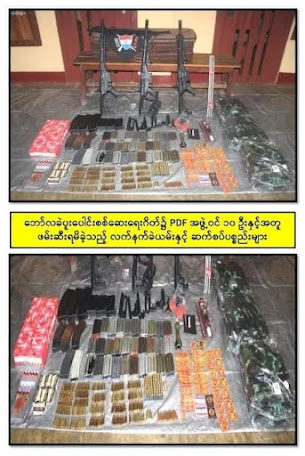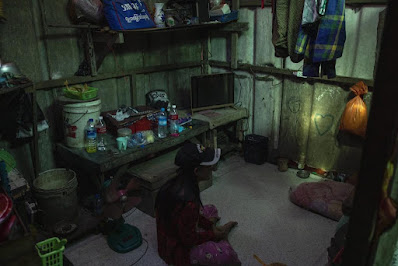(Staff article from the FRONTIER MYANMAR on 01 March 2022.)
 |
| Everyone rebelling against Myanmar Army. |
First, they marched in the streets. Then, they
walked off their jobs. Now, they’ve picked up arms. On February 1, 2021,
Myanmar’s military – despite already being in control of several key ministries
and holding de facto veto power over any amendments to the constitution it
wrote and implemented – decided it had tired of quasi-democracy and staged a coup
d’etat.
The people of Myanmar, no strangers to military dictatorship, decided virtually unanimously that they could not accept this. In the weeks following the coup, the entire country erupted in street protests attended by millions. Hundreds of thousands of public servants walked off their jobs, refusing to work for a military-controlled government and bringing nearly all administrative functions to a halt.
Within weeks, the junta began meeting peaceful protests and acts of civil resistance with increasing levels of violence. Hundreds of protesters were soon dead in the streets, leaving many feeling they had no option but to begin waging what they call a defensive war.
More than a year on, foreign investment has vanished
and jobs are scarce. The kyat’s value has plummeted, pushing prices of imported
commodities – including essentials like fuel, fertiliser and cooking oil – to
new heights. And there seems to be no end in sight to what has become an
all-out civil war, one that has more than doubled the number of displaced
people in Myanmar.
A ‘people’s defensive war’
By April and May
2021, many young people across the country had begun joining small, local armed
resistance groups. These groups, which were formed in both urban and rural
areas, began with homemade hunting rifles and bombs, and scored a number of
early combat successes with guerrilla tactics. Some have since evolved to using
landmine and drone attacks, according to local media reports, and have been
able to access modern weapons, including handguns, assault rifles and even
rocket-propelled grenades.
On May 5, 2021, the National Unity Government, the
civilian-led parallel administration, announced the establishment of an armed
wing, the People’s Defence Forces. Some, but not all, of the local armed groups
that had sprung up since the coup, aligned themselves with the NUG, even
renaming themselves PDFs. Four months later, NUG Acting President Duwa Lashi La
announced a “people’s defensive war”, calling on the people to revolt against
the military junta and for the PDFs specifically to attack military assets and
to protect civilians.
Some PDFs and
other resistance forces have members with a background in the Tatmadaw; as of
January, more than 2,000 police and soldiers had defected from the military,
according to People’s Embrace, an organisation established by defected military
members that now helps others defect, and some have taken up arms for the
resistance. Junta spokesperson Major-General Zaw Min Tun has publicly disputed
this number, though admits a “small number” of defections have occurred among
the armed forces.
Most PDFs
operate outside urban areas, and many have close ties to long-established
ethnic armed groups, which have provided some weapons and training. Their urban
counterparts – known as Pa Ka Pha, a Burmese acronym similar to PDF but
connoting their urban, guerrilla tactics – operate more clandestinely in
Myanmar’s major cities.
Ko Aung Linn,
the leader of an urban guerrilla unit in southern Yangon Region, said his group
has launched at least 30 attacks against military-linked targets within their
operational zone. Despite their successes, resistance groups remain largely
outnumbered and overpowered by the Tatmadaw, and many have found it hard to
obtain weapons and ammunition.
An increased
military presence along most trade routes has made transporting weapons
difficult, particularly since December when the military invaded the Karen
National Union-controlled town of Lay Kay Kyaw in Kayin State’s Myawaddy
Township. Lay Kay Kaw had served as an important transit point for weapons
heading to resistance groups in Yangon, Aung Linn said, a claim that the junta
has also made.
Ko Zayar Lwin
serves in a resistance group known as No 2 Kyar Phyu Company (kyar phyu means
“white tiger” in Burmese). Although the group is under the NUG’s Southern
Regional Military Command, he said the parallel administration has provided
just a “handful” of weapons and called on it to work more closely with the
PDFs, urban guerrilla groups and ethnic armed groups. “We have to rely on
individual donors and homemade devices for weapons,” he told Frontier.
Still, despite a
lack of resources, many fighters that Frontier spoke to remain optimistic. “Initially,
we sometimes missed our target, but now our attacks have become more precise,
and each causes more severe damage to the Tatmadaw than the previous one,” said
a member of a resistance group in Yangon’s Hmawbi Township, who asked not to be
named due to security concerns.
No end in sight
Resistance has
been particularly fierce in Kayin, Chin and Kayah states and Sagaing and Magway
regions, with fighting – and junta atrocities – being reported on a near-daily
basis. Most of these areas had not seen significant fighting in recent years,
and majority-Bamar Sagaing and Magway have been almost entirely insurgency-free
for decades.
It is in these
states and regions that the anti-coup movement has claimed some of its greatest
victories, although many of these reports have been difficult to confirm.
In Chin State,
70 percent of police and around 200 soldiers have defected to local armed
resistance groups, Chin National Front spokesperson Salai Htet Ni said. And the
Chinland Joint Defence Committee Forces, which brings together 16 local armed
groups, claimed that 184 clashes in Chin State and Sagaing Region from April to
December 2021 had resulted in 1,029 Tatmadaw deaths and only 58 CJDCF deaths.
Htet Ni told
Frontier he believes these numbers will only increase as the resistance ramps
up its operations.
In Kayah, the Karenni Nationalities Defence Force –
a coalition of newly formed armed groups that fights together with the Karenni
Army, the armed wing of the Karenni National Progressive Party – claimed in a
recent report that it now controls 90pc of the state.
The KNDF, which says it has 6,277 soldiers in 18 battalions, lost 20 soldiers in 110 clashes with the Tatmadaw in the past year, in contrast to the 1,140 Tatmadaw deaths it inflicted, the report said.
In Kayin,
meanwhile, more than 3,000 clashes have broken out between the Karen National
Liberation Army, armed wing of the Karen National Union, and the Tatmadaw since
the coup, with 2,190 Tatmadaw and 43 KNLA deaths, according to a report the
group issued on January 7.
With limited
independent monitoring, many suspect these groups may be inflating the number
of Tatmadaw deaths and downplaying their own losses. Nevertheless, they do
reflect the seriousness of the conflict.
“There is
fighting every day, and very little chance it will end soon,” KNU spokesperson
Padoh Saw Taw Nee told Frontier. “The regime is increasing its troop presence.
They’ve ignored our demand to withdraw their troops.”
Duwa Lashi La
said in a video message posted to the NUG’s Facebook page to mark the coup’s
February 1 anniversary that 7,016 Tatmadaw soldiers had been killed between
September 7 and January 6.
He called this
figure “an important victory for the revolutionary forces”, describing the
collaboration among PDFs and allied armed groups as “a precursor to the
emergence of a federal union army”, affirming that the fighting is only going
to escalate in the months to come.
The fighting has
displaced about 440,000 people since the coup, the UN refugee agency said in
early February – that is in addition to the roughly 370,000 people who had fled
their homes before the coup.
People living in
conflict areas report regular Tatmadaw air strikes, as well as indiscriminate
killings, arbitrary arrests and detentions, torture, rpes, property
confiscation and the wanton destruction of religious sites.
“The worst has
been the shelling of villages with heavy artillery and the destruction of
religious buildings,” said one woman, a mother of two boys who fled from Chin
State’s Mindat Township. Her house was later destroyed by Tatmadaw artillery,
she said. “We abandoned our homes as soon as military troops approached the
village.”
She is taking
refuge in a camp along the border between Chin State and Magway Region. Most
other Mindat residents have also fled, many to makeshift camps along the
Myanmar and Indian borders, or into India itself.
Local charity
groups trying to help those who remain inside the country say they are running
out of food – a warning that humanitarian groups working elsewhere in Myanmar
have echoed. “We are beyond capacity for both food and shelter,” said the
leader of a local charity group in Kayah, where more than 170,000 people have
been displaced alone, according to the Karenni Human Rights Group.
A ‘desperate situation’
City dwellers
say junta forces are making life harder for them as well, increasingly checking
homes and searching pedestrians at random. Arbitrary arrests of young people,
who are then accused of participating in or having connections to anti-regime
activities, are also reportedly common. This has created a climate of fear in
many cities.
“It is very rare to see people walking outside after
8pm,” said Daw Nwe Nwe Win, a mother of two teenage sons in Mandalay’s Chan Mya
Tharzi Township. “But even staying inside, we don’t feel completely safe.
Anyone can be arrested without reason during guest registration inspections.”
Fighting and political instability have also
devastated the economy. With the kyat losing much of its value, prices are
reaching unattainable levels at the same time that jobs are drying up. The
World Bank and others say the economy likely shrank by 18 percent in the year
to September 30, 2021, and will see little if any growth this year. More than
half of the population is expected to fall into poverty.
Ma Zin Mar Win,
a 23-year-old former garment worker, has been out of work since the Hengmao
(Myanmar) Garment factory in Yangon’s Hlaing Tharyar Township closed last June,
shortly after she became pregnant.
“When I lost my
job, I relied on my husband’s income. But [in November] he lost his job, too,”
she told Frontier. While pregnant, Zin
Mar Win contracted COVID-19. One month after giving birth, her baby girl died
due to complications from the virus. “I have no idea how to overcome this
desperate situation,” Zin Mar Win said.
The International Labour Organization recently estimated that 1.6 million jobs were lost in Myanmar over the past year, while working hours are thought to have declined by 18 percent – equivalent to the working time of another 3.1 million full-time jobs.
Ma Hnin Htwe, a
former deputy officer in the Ministry of Commerce’s Trade Department, took to
the streets with the first wave of protesters in February 2021. She and several
colleagues then walked off their jobs, joining the Civil Disobedience Movement.
She thought business owners would have admired her courage and offered her
work, but that hasn’t been the case, she said.
“They are afraid
the Tatmadaw will run them out of business if they hire us,” she told Frontier.
“Even as a computer technician, finding work has been a struggle. I’ve been
rejected four times by company owners who know I joined the CDM.”
These struggles are compounded by rising prices on
virtually all goods. Before the coup, one litre of fuel cost around K700 kyat;
it now costs more than K1,600. This has been particularly hard on taxi drivers.
It’s the worst
economic climate that 60-year-old U Aung Khin, a driver in Yangon’s North
Okkalapa Township, can recall in decades. Aung Khin said that in September he spent
K6,000 a day on fuel and took in about K30,000 in fares. “Now I spend K30,000
on fuel a day, but get only K40,000 [in fares].”
But fuel isn’t a
taxi driver’s only cost. Most rent their cars by the day. Luckily, the owner of the car that Aung Khin
rents has been sympathetic. When fuel prices rose in November, the owner,
knowing the standard rental fee would eat up the rest of Aung Khin’s revenue,
stopped charging him for the car. “If I
were paying K10,000 to rent the car, I’d be earning nothing right now,” Aung
Khin said.
Even with such
compassion, Aung Khin worries about how he is going to feed his family. Food
distributors say the price of imported foods has risen by between 20pc and 50pc
due to the devaluation of the kyat. Cooking oil alone has risen from K2,000 per
viss (the equivalent of about 1.6 litres) to K5,000. “This is the highest price
we’ve ever seen for cooking oil,” said Daw Myint Myint Win, a retailer and
wholesaler in Mandalay’s Meiktila Township.
‘More people will suffer’
Political
analysts predict a worsening crisis on all of these fronts in the coming year. Civilian
deaths due to conflict are at their highest level in Myanmar since 1989,
according to the Institute for Strategy and Policy-Myanmar, a Yangon-based
think tank.
Based on
reporting from the local monitoring group, the Assistance Association for
Political Prisoners, and the junta itself, it said nearly 3,600 non-combatants
were killed in 2021. This includes not only those killed in fighting between
armed groups, but also deaths as a result of regime crackdowns and torture while
in custody, and targeted assassinations of informants and civil servants.
Still, many see
no alternative.
On February 1,
the commander-in-chief extended the junta’s mandate for another six months.
Meanwhile, the NUG has pledged to step up its armed resistance. “The military
council may respond with more violence as the people’s defensive war
strengthens,” NUG Defense Minster U Ye Mon warned on February 1, urging PDFs to
respond with “appropriate military tactics”.
“The
international community is still talking about the path of dialogue to restore
democracy in Myanmar, but the people of Myanmar no longer trust dialogue,” said
U Khin Zaw Win, executive director of the Tampadipa Institute, which works on
policy development and capacity building. “That has already been tried in
Myanmar for years; it didn’t work.”
He predicts more
fighting in the year to come. “As the time goes on,” Khin Zaw Win said, “more
people will suffer.”












